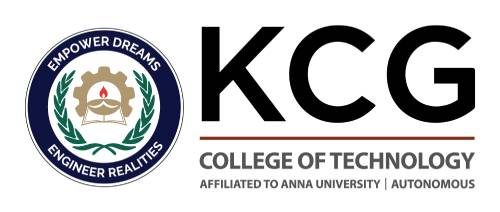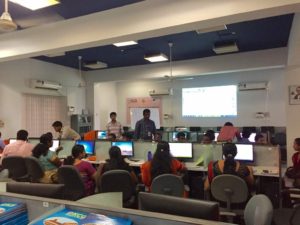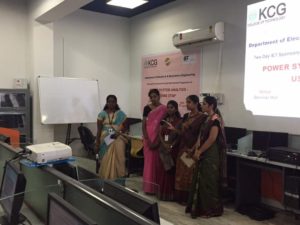KCG COLLEGE OF TECHNOLOGY
CHENNAI
TWO DAY FDP ON “POWER SYSTEM ANALYSIS – USING ETAP”
The Department of Electrical and Electronics, KCG College of Technology organized an IET sponsored TWO-DAY FACULTY DEVELOPMENT PROGRAMME ON “POWER SYSTEM ANALYSIS – USING ETAP” on June 22nd & 23rd, 2017. The inaugural function commenced at 9.30 am in MCA LAB. The meeting was formally begun with an invocation and the invited guests were welcomed by Dr. P.Deiva Sundari, Head of the Department/EEE. Around 42 participants registered for the programme.
Day 1 – Session 1
Mr.Gandhirajan, Petro6Engineering & Construction Pvt. Ltd, Chennai
Topic: Load Flow Analysis – Case Study & Hands-on for Industrial System
He started the session saying about the (Electrical Transient Analyzer Programme) ETAP software and its purpose. He elaborated how ETAP is used to perform load flow analysis, short circuits, transient instabilities, harmonics, relay coordination, arc flash, optimal power flow and battery sizing. He explained the load flow analysis using ETAP with a case study.
Day 1 – Session 2
Mr.Prasanth, PowerProjects, Chennai
Topic: Case Study & Hands-on – Utility System – Ferranti Effect, Shunt & Series Compensation, Power Factor Correction
He introduced the concepts of Ferranti effect and skin effect. He also explained how the receiving end voltage is greater than sending end voltage in long, High Voltage and Extra High Voltage transmission lines, during light loads or no load condition, because of the presence of shunt capacitance. He also explained how to prepare the reports using ETAP Software.
Day 1 – Session 3
Mr.Emmanuel, Voltech Engineers Pvt ltd, Chennai
Topic: Generator Modeling, Control Mode, Emergency Diesel Generator
He explained about dependent machine and network models using full frequency, cold-state starting of generators under normal and emergency conditions. The entire generator start-up process includes automatic control relay simulation and dynamic behaviors of exciters-AVR, governor, turbine /engine, and Power System Stabilizers (PSS). He showed how ETAP can be utilized to simulate detailed dynamic responses of the starting generator, test emergency loads including motors, MOV and others connected to the generator before it reaches the synchronous speed and rated voltage.
Day 2 – Session 1
Mr.Gandhirajan, Petro6Engineering & Construction Pvt. Ltd, Chennai
Topic: Short Circuit Studies – Balanced and Unbalanced Faults, Modeling of Circuit Breakers, Transformers
He explained about the concept of short circuit studies due to balanced and unbalanced faults. He also explained with a sample model using ETAP software.
Day 2 – Session 2
Mr.Prasanth, PowerProjects, Chennai
Topic: X/R Ratio, Case Study & Hands-on for Power Plant, Selection of Transformer Impedance
He gave an insight about the X/R ratio. The major points discussed were:
In short circuit studies, the X/R ratio should not be ignored because it determines the peak asymmetrical fault current. When comparing the short circuit current from the studies against circuit breaker name plate, one should know at what X/R ratio the circuit breaker was tested. The following rule of thumb can be used to determine if circuit breaker is properly rated:
- Symmetrical short circuit current is less than symmetrical rating of the circuit breaker, and
- X/R of the circuit is less than circuit breaker test X/R ratio
If the first item is met but the second is not, then the process of circuit breaker evaluation requires further calculation.
Day 2 – Session 3
Mr.Berwin, PowerProjects, Chennai
Topic: Introduction to Transient Stability Studies, Generator Relative Angle Generator outage Modeling of AVR & Governor
He explained about the transient stability studies for a sample system shown below. Transient stability studies include identifying critical fault clearing time, checking generator rotor angle stability, assessing system stability margin, evaluating motor dynamic acceleration and re-acceleration impact, preparing and testing load shedding schedule, computing fast bus transfer timing, calibrating and evaluating relay setting and simulating generator start-up.
Day 2 – Session 4
Mr.Tamil, PowerProjects, Chennai
Topic: Harmonic Analysis – IEEE519, Modeling of Non-linear Loads, Filter Sizing Relay Coordination with examples
He explained about transient stability studies for a sample system with the harmonic analysis module and the following points were discussed:
- Simulate harmonic current and voltage sources, identify harmonic problems, reduce nuisance trips, design and test filters, and report harmonic voltage and current distortion limit violations.
- Comprehensive load flow and frequency scan calculations and power system component frequency models.
- Results were shown graphically, including harmonic order, harmonic spectrum plots, and harmonic waveform plots.
The programme concluded with feedback from the participants and certificate distribution by the Dr. P. Deiva Sundari, HOD/EEE, KCG College of Technology.












